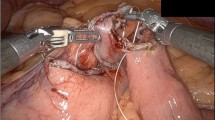Abstract
Exposure of the ligament of Treitz for Roux limb construction during laparoscopic gastric bypass requires either division or displacement of the omentum. Factors compromising this exposure include: (1) a bulky omentum, (2) hepatomegaly, (3) adhesions between the omentum and lower abdominal wall or pelvic contents and (4) inability to identify the transverse colon because of overlying adipose tissue. The lesser sac approach is an alternative method for Roux limb construction during laparoscopic gastric bypass when access to the inframesocolic abdomen is difficult. In this technique the lesser sac is entered through the gastrocolic ligament. The transverse mesocolon is then opened and the ligament of Treitz is identified. The jejunum is pulled into the lesser sac and the Roux limb is constructed. The jejunojejunostomy is reduced into the inframesocolic compartment, the mesenteric defects are closed, and the remaining portion of the procedure is completed. This technique provides an alternative method for completion of a laparoscopic gastric bypass in patients who would otherwise require more extensive surgery.



Similar content being viewed by others
References
Dallal RM, Bailey LA (2006) Omental infarction: a cause of acute abdominal pain after antecolic gastric bypass. Surg Obes Relat Dis 2:451–454
DeMaria EJ, Sugerman HJ, Kellum JM, Meador JG, Wolfe LG (2002) Results of 281 consecutive total laparoscopic Roux-en-Y gastric bypasses to treat morbid obesity. Ann Surg 235:640–647
Filip JE, Mattar SG, Bowers SP, Smith CD (2002) Internal hernia formation after laparoscopic Roux-en-Y gastric bypass for morbid obesity. Am Surg 68:640–643
Higa KD, Boone KB, Ho T (2000) Complications of the laparoscopic Roux-en-Y gastric bypass: 1,040 patients – what have we learned? Obes Surg 16:1265–1271
Higa KD, Boone KB, Ho T, Davies OG (2000) Laparoscopic Roux-en-Y gastric bypass for morbid obesity: technique and preliminary results of our first 400 patients. Arch Surg 135:1029–1034
Iannelli A, Facchiano E, Gugenheim J (2006) Internal hernia after laparoscopic Roux-en-Y gastric bypass for morbid obesity. Obes Surg 16:1265–1271
Schauer PR, Ikramuddin S, Gourash W, Ramanathan R, Luketich J (2000) Outcomes after laparoscopic Roux-en-Y gastric bypass for morbid obesity. Ann Surg 232:515–529
Wittgrove AC, Clark GW (2000) Laparoscopic gastric bypass, Roux-en-Y – 500 patients: technique and results, with 3-60 month follow-up. Obes Surg 10:233–239
Author information
Authors and Affiliations
Corresponding author
Electronic supplementary material
Supplementary material
Rights and permissions
About this article
Cite this article
Kligman, M.D. A novel approach for Roux limb construction via the lesser sac. Surg Endosc 21, 1194–1197 (2007). https://doi.org/10.1007/s00464-007-9304-y
Received:
Revised:
Accepted:
Published:
Issue Date:
DOI: https://doi.org/10.1007/s00464-007-9304-y




